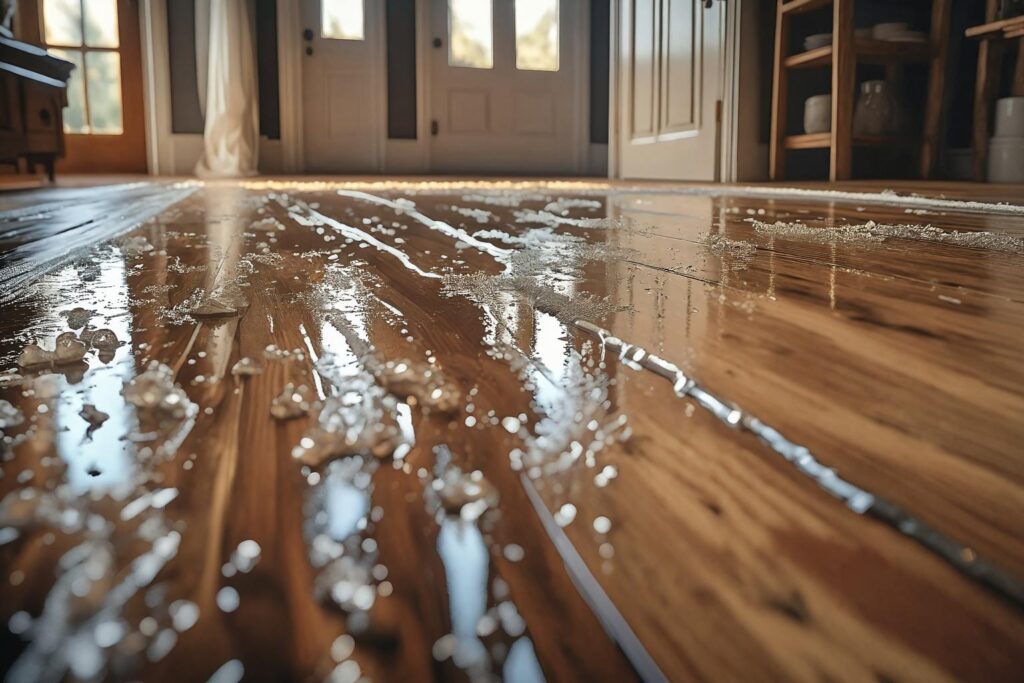
Contents
When faced with water damage, you must consider the environmental impact of your repair methods. By exploring innovative solutions such as plant-based cleaners, biodegradable materials, and solar-powered tools, you can effectively address water damage while being mindful of sustainability. These eco-friendly approaches safeguard the environment and offer long-term benefits for your home or business. But what exactly makes these methods the top choices for environmentally conscious individuals?
Key Takeaways
- Plant-based solutions effectively remove mold and mildew without harming the environment.
- Biodegradable materials break down naturally, reducing the impact on landfills.
- Solar-powered tools minimize carbon footprint and operational costs in water damage repair.
- Natural dehumidification techniques promote healthier indoor air quality.
- Rainwater harvesting and graywater recycling systems reduce reliance on traditional water sources.
Plant-Based Cleaning Solutions
When it comes to eco-friendly water damage repair methods, utilizing plant-based cleaning solutions proves to be a sustainable and effective approach. Green cleaning is an essential aspect of sustainable solutions, especially when dealing with water damage.
Plant-based cleaning solutions are derived from natural ingredients, making them biodegradable and non-toxic, unlike traditional chemical cleaners. These solutions help restore the affected areas and contribute to environmental preservation.
Plant-based cleaning solutions are effective in removing mold, mildew, and other contaminants that may result from water damage. The ingredients in these cleaners have natural antibacterial and antifungal properties, making them ideal for disinfecting and sanitizing water-damaged spaces.
Unlike harsh chemical cleaners that can leave harmful residues and fumes, plant-based solutions break down safely without polluting the air or water.
Furthermore, plant-based cleaning solutions are gentle on surfaces, preventing further damage during the restoration process. They’re safe to use around pets, children, and individuals with sensitivities to chemicals.
Biodegradable Absorbent Materials
Utilizing biodegradable absorbent materials is a vital component of eco-friendly water damage repair strategies. When addressing water damage, opting for sustainable solutions assists in the restoration process and contributes to environmental preservation. Biodegradable absorbent materials are designed to efficiently absorb excess water while being eco-friendly. These materials are typically made from natural components that break down over time, reducing the impact on landfills and ecosystems.
To highlight the benefits of biodegradable absorbent materials further, let’s explore a comparison between traditional absorbents and their environmentally friendly counterparts:
| Traditional Absorbents | Biodegradable Absorbent Materials |
|---|---|
| Often made from synthetic materials | Made from natural, biodegradable components |
| Contribute to landfill waste | Break down over time, reducing environmental impact |
| Require special disposal methods | Can be sustainably disposed of |
| May contain harmful chemicals | Environmentally safe and green building materials |
Choosing biodegradable absorbent materials assists in effective water damage repair and aligns with sustainable practices. Ensuring that the materials used in restoration processes are environmentally friendly is vital for reducing the overall carbon footprint and promoting a healthier ecosystem. Make the switch to biodegradable absorbent materials for a greener approach to water damage repair.
Solar-Powered Water Extraction Tools
To enhance the sustainability of water damage repair processes, incorporating solar-powered water extraction tools can significantly reduce the environmental impact of restoration efforts. These tools harness the power of green energy, making them an eco-friendly choice for water extraction post-damage. By utilizing solar energy, these extraction tools operate without depending on traditional electricity sources, reducing carbon emissions and energy consumption.
Solar-powered water extraction tools are a prime example of sustainable technology in action. They’re designed to be efficient and effective while minimizing their carbon footprint. These tools are equipped with photovoltaic panels that convert sunlight into electricity, powering the extraction process without adding to greenhouse gas emissions.
Furthermore, solar-powered water extraction tools are environmentally friendly and cost-effective in the long run. Once installed, they rely on free and renewable solar energy, reducing operational costs compared to conventional extraction methods. This makes them a sustainable choice for water damage restoration companies looking to minimize their environmental impact while maintaining efficient operations.
Natural Dehumidification Techniques
Implementing natural dehumidification techniques is a sustainable approach to moisture control in water damage repair processes. When dealing with water damage, utilizing eco-friendly building materials and sustainable ventilation strategies can assist in naturally removing excess moisture from the affected area. Eco-friendly building materials such as reclaimed wood, bamboo flooring, or recycled insulation aid in reducing environmental impact and contribute to regulating humidity levels in the space.
Incorporating sustainable ventilation strategies, like natural ventilation through windows and doors, can facilitate the circulation of fresh air and promote the evaporation of moisture. Opening windows strategically to create cross ventilation can help in drying out damp areas efficiently.
Additionally, using exhaust fans or installing a whole-house ventilation system can assist in maintaining the best indoor air quality while reducing humidity levels.
Plants can also play a role in dehumidifying spaces naturally. Indoor plants like peace lilies, Boston ferns, or spider plants can absorb moisture through their leaves and help purify the air simultaneously. Integrating these natural dehumidification techniques aids the water damage repair process and aligns with eco-friendly practices, promoting a healthier and more sustainable living environment.
Rainwater Harvesting for Reuse
When it comes to eco-friendly water damage repair methods, utilizing rainwater harvesting for reuse can be a sustainable solution. By collecting rainwater for irrigation purposes, you can reduce your reliance on traditional water sources.
Additionally, implementing a greywater recycling system and stormwater management techniques further enhances your water conservation efforts.
Rainwater for Irrigation
Considering the increasing need for sustainable water management practices, one effective method gaining traction is the utilization of rainwater for irrigation purposes. By collecting rainwater and repurposing it for watering plants and gardens, you can reduce reliance on freshwater sources and lower your water bills while contributing to environmental conservation efforts.
Rainwater for Irrigation
When it comes to irrigation efficiency, using rainwater can be incredibly beneficial. Rainwater is free from chemicals often found in tap water, making it healthier for plants. Additionally, rainwater is naturally soft, reducing the risk of salt buildup in soil compared to hard water from the tap.
| Benefits of Rainwater for Irrigation | Efficiency of Rainwater Irrigation |
|---|---|
| Chemical-free water for plants | Reduced water bills |
| Soft water reduces soil salt buildup | Environmentally sustainable |
Graywater Recycling System
Utilizing a greywater recycling system, also known as rainwater harvesting for reuse, presents a sustainable solution for water conservation and efficiency in residential and commercial settings. This system collects water from sources like sinks, showers, and washing machines, treating it for reuse in non-potable applications such as toilet flushing, irrigation, and laundry. By diverting this graywater away from the sewage system, you decrease the strain on freshwater resources, lower utility bills, and decrease the demand for treated water.
Sustainable plumbing practices are vital for implementing a successful graywater recycling system, ensuring that the water is properly collected, stored, and distributed. Incorporating filtration systems and regular maintenance is essential to prevent clogs and maintain water quality.
Embracing graywater recycling is a practical step towards sustainable living, promoting water conservation and responsible resource management in both residential and commercial environments.
Stormwater Management Techniques
How can we effectively manage stormwater to promote sustainability and reduce environmental impact? One efficient method is through rainwater harvesting for reuse, a sustainable practice that plays an important role in green infrastructure and sustainable drainage systems. By collecting rainwater from roofs and other surfaces, we can reduce the strain on traditional water resources while also preventing flooding and erosion.
Rainwater harvesting involves the collection, storage, treatment, and distribution of rainwater for various purposes like irrigation, toilet flushing, and even laundry. This technique conserves water and reduces the demand for treated water, which in turn lessens the energy required for water treatment processes.
Implementing rainwater harvesting systems in both residential and commercial buildings can significantly contribute to sustainable water management practices. We can effectively manage stormwater and promote environmental sustainability by incorporating green infrastructure elements like rain barrels, cisterns, and permeable pavements.
Embracing sustainable drainage solutions like rain gardens and swales further enhances the efficiency of rainwater harvesting systems, making them essential tools in eco-friendly water damage repair methods.
Composting Wet Building Materials
When handling water-damaged building materials, a sustainable approach to managing the aftermath is vital.
Composting wet building materials can be a beneficial way to handle the organic waste generated from water damage repair while reducing the environmental impact. Instead of sending these materials to landfills where they’d add to greenhouse gas emissions, composting allows for the natural breakdown of the materials, transforming them into nutrient-rich compost that can be used for soil enrichment.
Composting wet building materials involves separating them based on their compostability. Materials like wood, cardboard, and drywall can be composted, while items like plastics or treated wood should be disposed of through more traditional means.
By composting organic waste from water-damaged materials, you aren’t just diverting waste from landfills but also creating a valuable resource that can enhance soil health and support plant growth.
To ensure a sustainable disposal process, it’s important to monitor the compost pile’s moisture levels and turn it regularly to promote proper decomposition. Once the composting process is complete, the resulting material can be used to enrich soil in gardens, landscaping projects, or agricultural settings.
Composting wet building materials is a practical and eco-friendly solution that aligns with the principles of sustainability and environmental stewardship.
Eco-Friendly Mold Remediation Methods
When addressing mold growth in a manner that’s environmentally aware, employing eco-conscious mold remediation methods becomes essential. Sustainable disinfection methods play a vital role in making sure that mold is removed effectively without harming the environment. Utilizing non-toxic mold removal products that are biodegradable and safe for both humans and nature is fundamental to green building practices.
In eco-conscious mold remediation, it’s crucial to focus on energy-efficient drying techniques to prevent further mold growth. By using innovative drying technologies that consume less energy, you can mitigate the environmental impact while effectively removing moisture from the affected areas. These methods save energy and contribute to sustainable practices in mold remediation.
Green building practices emphasize the use of environmentally friendly materials and processes, which can be extended to mold remediation. Incorporating eco-conscious mold removal techniques safeguards the environment and promotes healthier indoor air quality.
Summary
By adopting eco-friendly water damage repair methods, we are restoring damaged areas and nurturing the environment back to health. Like a gentle rain shower replenishing the earth, these sustainable practices symbolize a harmonious balance between restoration and conservation. Let us continue to tread lightly on our planet, using nature-inspired solutions to heal and protect our homes and surroundings for a greener future.
Recent Posts
What Are Eco-Friendly Water Damage Repair Methods?
When it comes to addressing water damage in an environmentally friendly manner, eco-conscious methods are
Sustainable Water Damage Repair Techniques: A How-To Guide
When faced with water damage in your home, it’s crucial to explore sustainable repair techniques
DIY Home Water Removal Tips for Emergencies
If you’ve ever experienced a burst pipe flooding your basement, you know the panic of
